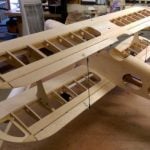Share your experience with bandsaws
Welcome! / Forums / General Woodworking Discussions / Woodworking Methods and Techniques / Share your experience with bandsaws
Tagged: bandsaw resaw
- This topic has 33 replies, 20 voices, and was last updated 2 years, 10 months ago by
George Scales.
-
AuthorPosts
-

I have a 10″ Rikon bandsaw that I picked up a few years back when Woodcraft had it on sale. I invested in a few different sized Timberwolf blades and spent a bit of time fiddling with the setup based on the tips in Alex Snodgrass’ bandsaw clinic video, and have been thrilled with what this inexpensive little tool has been able to deliver. I made myself a resaw fence and an oversized table for larger pieces (I made a rocking horse for my grandson and the stock table was just too small). For dust collection, I just attach my shop vac to the dust port, which keeps the mess to an acceptable level.
If you haven’t seen it, Alex Sondgrass’ Bandsaw Clinic Video is an excellent brand agnostic set of tips for setting up and dialing your bandsaw. I was amazed at how much better my saw performed after tuning up my saw based on his instructions.
I will probably step up to a 14″ saw at some point since the resaw capacity of my little 10″ is so limited, but for now, I am quite happy and could not imagine not having a bandsaw as part of my workshop.
12 May 2020 at 2:12 am #660974I’m on my second bandsaw.
I started with a 10″ Wen, which was a pretty good little saw. Very few features, but a great price at $275 USD. It was good enough for long rips and I was quite happy with it; however, it didn’t have great resaw capacity. It was billed at 6-in of resaw, but really struggled when pushed above 3-in.
I upgraded to a Laguna 14bx mainly for the resaw capacity (13in), as I have plans for a few dining tables in the future. I’m blown away by it. It saves me so much time dimensioning lumber, which allows me more time to do the fun stuff. I don’t have a thickness planer, but this bandsaw gets me close enough that I only have minimal planing to do.
The added safety features of the Laguna, compared to the Wen, are also great.
20 May 2020 at 1:34 pm #662188I got a 14 inch Laguna BX band saw January 2019. My shop is in my basement, and I use both power tools and hand tools. I use a shop vacuum for dust collection. The band saw has been a great addition to my shop. I have been surprised how often I end up using it. being able to easily and accurately re-dimension lumber and make curved cuts quickly has been really helpful. The saw has performed well, and the dust is minimal with the shop vac solution. Less dust than a handsaw really, since it disappears in the vacuum.
The band saw itself is quiet when running, no need for hearing protection, but the shop vac is a banshee, so I need the hearing protection if I want the dust collection. I have run it without dust collection, it does not create that much dust, but to avoid opening the cabinet and vacuuming it out, I prefer to have dust collection.
I do not think that it has helped me develop hand tool skills faster, instead what it does is save me time and effort for those tasks I would rather get over with, so I can spend my time on those tasks I want to focus on. It is a great supplement to my hand tools. And, something about a bandsaw is surprisingly engaging, or intuitive to use, compared to the various circular bladed power tools I have used. Easy to see what the blade is doing, and feels much, much safer than a table saw or radial arm saw while I am using it. It has been surprising how often I now re-dimension lumber, whereas before I rarely did that, it was just too much trouble.
It was a chore getting it into the basement, but slow and carefully wins the day. It was not too bad lifting up, but I got my son to help, and that was mostly to reduce the risk of it slipping and falling back down. It is on a mobile base, so I can move it if needed, which is rare.
Having said all of that, I would summarize by saying it is a great tool to have if you want to make some tasks quicker and easier, but it comes with cost, dust (not a lot, but some) noise (mostly from the shop vac dust collection) and space needed for it. If you want to do hand work, and are happy to use your time to do the things the band saw can do, I see no reason to get one. You have to think about what is important to you. For example, if getting the job done quickly and easily so you can move onto the next job is important, then a bandsaw may be a good purchase. If wood working is your therapy, and hand tool woodworking is what you enjoy, then you may be better of with out a bandsaw. Introspection will help you sort this out.
20 May 2020 at 1:49 pm #662190I bought a lunchbox planer for a similar reason (speeding up some parts of the work so that I can get on with the challenging stuff). Although it gets less use than a bandsaw would, it does take up a lot less room in my small workshop and I can set it up on the workmate outside when I want to make noise and dust.

Ive been looking into this as well. Rather than fill my small workspace with a record or metabo bandsaw, Im considering going the other way and buying a proxxon machine. These are designed for smaller work – but for me thats the point. I can do accurate curves and angled cuts. The quality of the Proxxon Bandsaw seems very good indeed. The max height of any piece is about 8cm (3 inches) but for me that would be perfectly fine. Proxxon make a whole range of quality tools for smaller work.
I recently bought the 10” WEN 3692. I put in a 3 TPI hook blade and it did resaw 6 inches of beech pretty straight. I’m looking forward to trying a 3 TPI skip tooth for cleaner kerfs. I did have to fiddle the lower wheel tracking by the post behind the saw but that was simple enough. The saw is quieter than the shop vac used for dust. I went cheaper as a first saw until I can justify something like a 17” grizzly. I also just bought but have not received the dewalt 735 planer. I have built the skill to dimension by hand, but it just takes way too much time and energy away from everything else. The only other machine I’m considering is a lathe for pulls etc. With Paul’s methods and some practice I believe I can compete time wise with power tool users for all other tasks besides milling.
To do resawing you will want more power, 1 hp minimum, and the ability to tension wider blades. I have a 14″ Delta cast iron saw and the tension is probably inadequate for 1/2″ blades. My saw is 3/4 horse and bogs down in thick (8″) cuts.
The cast iron saw can be broken down into manageable pieces. The motor and stand moving seperately makes that easier. The casting and wheels can be grunted down a set of stairs.
I pushed my tablesaw aside to make space in my shop. For material breakdown I use a cordless circular saw for long cuts and the bandsaw for smaller. I’ll also resaw for big changes in thickness. The dust isn’t as bad as a tablesaw and I use a dust collector on the dust port to catch the free floating dust.
An update to my last comment.
Yesterday I tried out a Starrett 3/8 3tpi blade and sliced through 4″ of maple and walnut making perfect 1/16 slices. This blade is drastically different from the wood slicer and olson blade I had been using in terms of drift and power required. I can’t recommend these highly enough.
I had been planning to upgrade my motor but will hold off now pending more resawing experience.
I used the SFB model which is plain steel available from Woodcraft in the US. There is also a bimetal model available from Iturra designs.
-
This reply was modified 3 years, 6 months ago by
Cunha.
27 January 2021 at 12:45 pm #698766Dear Apprentices, Journeymen and Masters.
Here’s my experience if it helps? I work in a shared shop in the UK. We started with a second hand Record machine (350E) It is mainly used to rip larger pieces for stock prep. It needed a lot of adjusting and it didn’t always cut straight. After much adjustment and with a brand new blade it would cut a good straight line in 60mm Sapele. The blade guides have to be really carefully set and you must get the teeth right on the centre of the tyres. Because the machine is old it would not hold tension for long, the upper wheel adjustment was very worn. It was not noisy and you could get buy using a shop vac (Henry?) If you spent the time setting the machine up, it would do the job well, but you could never just walk up to it and go. However, because we are a shared shop, there’s no knowing how much use the machine was getting. I suspect it got some fairly hard abuse before it was key locked and made available only to users who could be bothered to read the manual. (The joys of a shared shop!) The machine is now semi retired and with light use it still does a reasonable job of ripping big bits.
We now have a Startrite 352 (second hand) I set it up for the first time yesterday. This is a much heavier and chunky machine and is therefore on wheels with wheel brakes. The setup was relatively easy. It came with a box spanner but you’ll need a ring spanner to adjust the guides. The blade tension is really simple to operate. With a new 1/2 inch 4tpi blade it ripped 60mm of oak in reasonably straight lines, but the timber was cupped and bowed.
Overall, I think bandsaws are good for stock prep. They are not accurate enough to do thicknessing and they cut nearly square depending on the timber so you still have some prep to do before you start work.
Hope that helps,
Mark
1 July 2021 at 6:12 pm #719396I just got my hands on a Czech made bandsaw (so English language documentation is rather scarce), a Proma PP-312 in case anyone is interested. It is in need of some maintenance and repair, but that won’t be an issue.
It has two speed settings, which you switch between by changing the drive belt/pulleys. It has two speeds, 360m/min and 780m/min. My question is (to those that have more than a single speed bandsaw), do you switch speed often (at all)? Which speed is your normal default, low speed or high speed?
I have a 2 speed bandsaw…
I have only ever used it on the higher speed…
I can’t remember where I got this information, but I recall being told, or reading somewhere, that basically it’s the faster speed for wood, the smaller speed for metal.
It was told as somewhat of a generalisation but it seems to make sense, and work.If you think about it, you can replicate the slower speed, if you need to, by feeding the wood in slower!.
Good luck,
Matt
2 July 2021 at 12:20 pm #719479I figured that was probably the case. The manual did not have any guidance (we do put that guidance in our manuals, lower speeds are for plastics and such).
15 July 2021 at 9:35 pm #721163Next bandsaw question. I had to replace a broken casting that held the trunnion in place. So now I will have to reset the position of the table. I will put a blade in the saw, set the blade so that it is tracking on the center of the top wheel. Am I right in thinking that to now be able to align the miter slot to the blade, I would plane a piece to fit snugly to the miter slot, then put a piece of ply against the snugly fitting piece, and in contact with the blade, mark the point the blade touches the ply, parallel that line down the board and then make a cut, and see if the saw cuts along the line, or veers away from the line? Or does anyone know a different way?
I do not have any of the fences or accessories with this saw, I will be making my own, but I need the table to be aligned first.16 July 2021 at 9:56 am #721220have a look at the video by Michael Fortune: how to eliminate drift from your bandsaw.
-
This reply was modified 3 years, 6 months ago by
-
AuthorPosts
- You must be logged in to reply to this topic.
